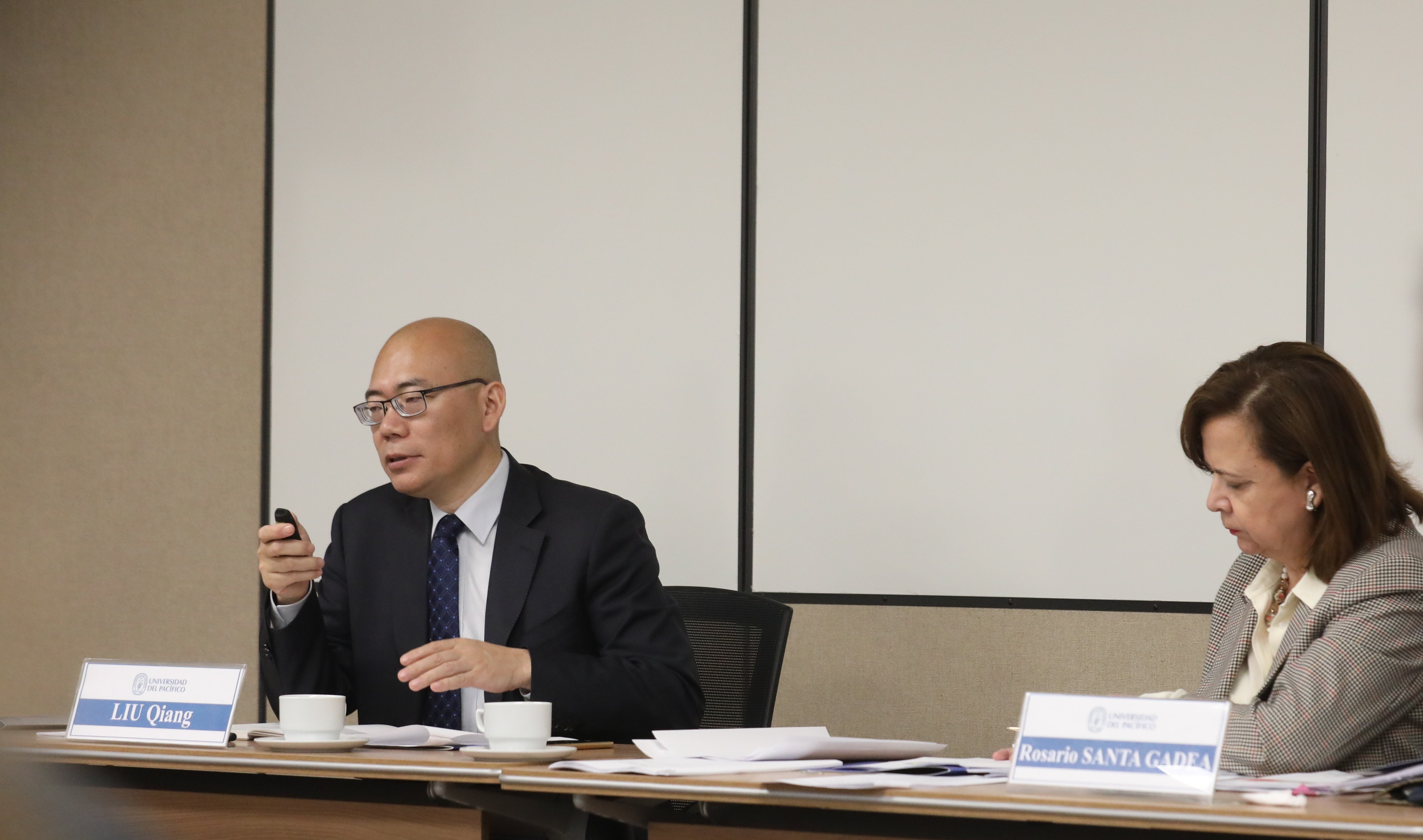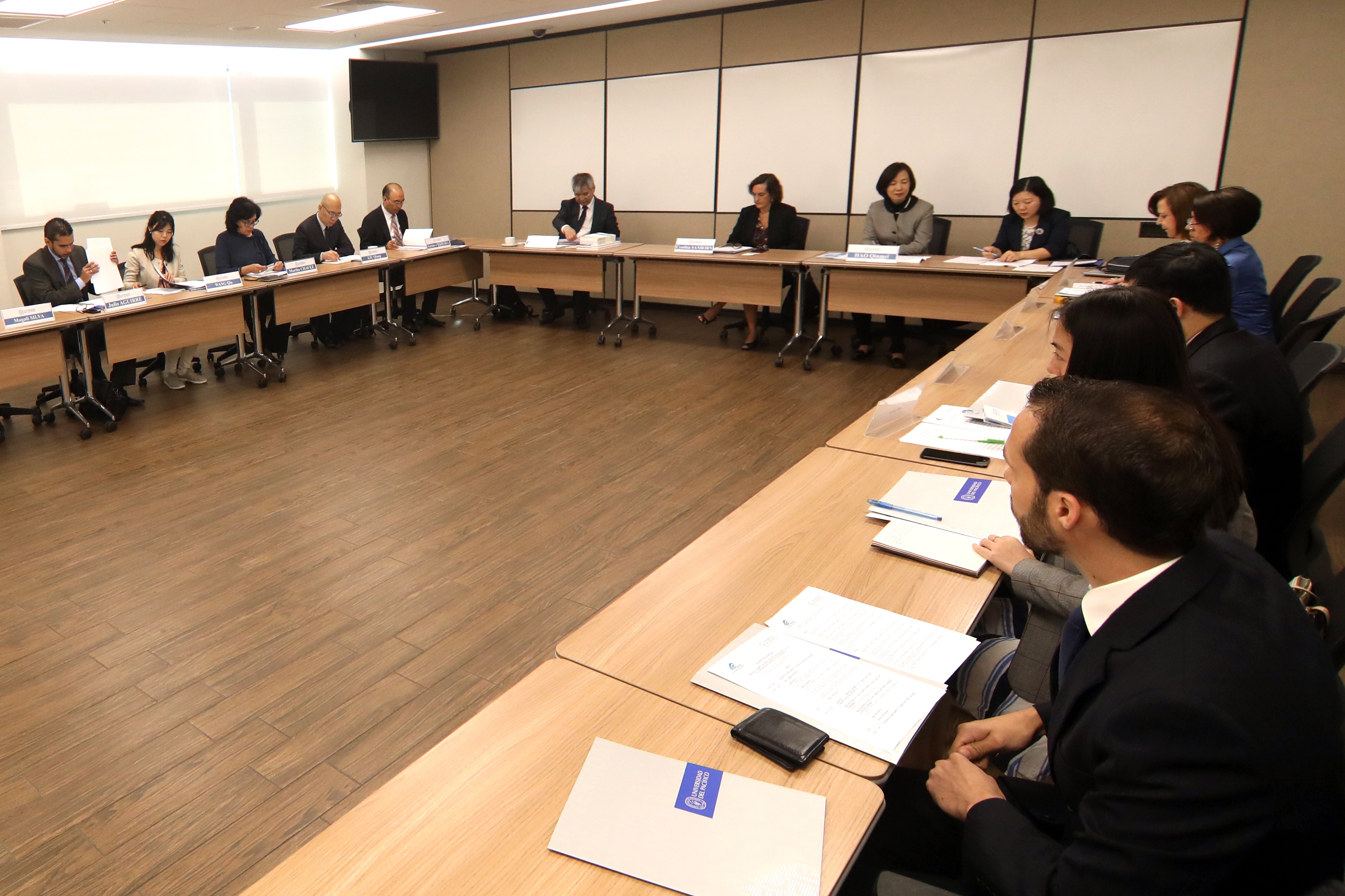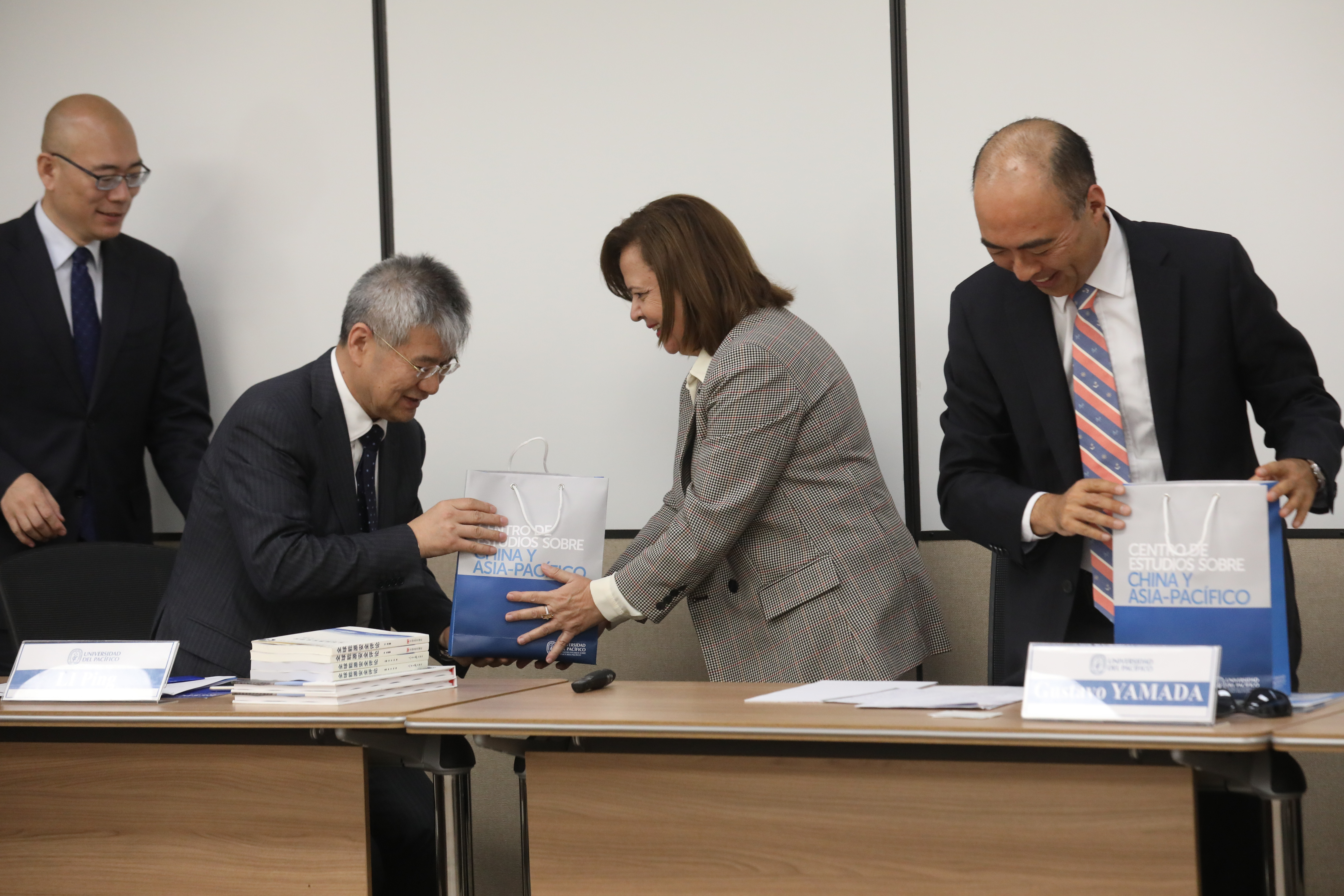The Universidad del Pacífico Center for China and Asia-Pacific Studies organized a workshop with experts from the Institute of Quantitative and Technical Economics of the prestigious Chinese Academy of Social Sciences (IQTE-CASS). The event brought together the visiting delegation and a group of specialists from Universidad del Pacífico, as well as some guest experts on specific topics, for a fruitful internal knowledge exchange workshop on China and Peru, in relation to macroeconomics, regional integration and energy.
At the opening of the event, Universidad del Pacífico Vice President for Research, Dr. Cynthia Sanborn, and the Economic and Commercial Counselor of the Embassy of the People's Republic of China, Ms. HAO Qinmei, highlighted the importance of bringing together high-level academics from China and Peru to exchange perspectives on issues relevant to bilateral relations.
The visiting delegation was led by the Director General of the IQTE-CASS, Professor LI Ping, expert in macroeconomics with extensive experience in strategic planning and macroeconomic projections at national, regional and sectoral level in China. Professor LI gave an overview of the Chinese economy in a talk in which he stressed that his country is experiencing a "new normal" with lower economic growth rates and less dependence on capital formation". However, China will continue to grow consistently and it is expected that "by 2023, it will have overcome the middle income trap, reaching the high-income country classification" and "by 2030, the country will have surpassed the United States in total economic production, becoming the largest economy in the world".
On the Peruvian side, Dr. Gustavo Yamada, director of the Universidad del Pacífico Research Center, explained the situation, trends and challenges of Peru in the Latin American and global environment. In his presentation, Dr. Yamada stressed that the Peruvian economy has achieved important results in recent years: "In the period 2007-2017, Peru had the fifth highest GDP per capita growth rate among emerging countries (3.8%), the highest among Latin American countries".
Also, Peru's economic growth has slowed, but a quick recovery is projected. "In the last two years, the Peruvian GDP annual growth rate (in real terms) has slowed to 3%, but it is expected to reach 4% this year and 5% towards the end of the decade", he explained.
 Universidad del Pacífico authorities participated in the workshop.
Universidad del Pacífico authorities participated in the workshop.
In terms of regional cooperation, Dr. Liu Qiang, co-chair and secretary of the Global Forum on Energy Security and director of the Energy Division at the IQTE-CASS, and Dr. Rosario Santa Gadea, director of the Center for China and Asia-Pacific Studies talked about China's Belt and Road initiative.
As reported by Dr. Santa Gadea, the Belt and Road is an initiative proposed by President Xi Jinping, in 2013, in which "connectivity is conceived as a new platform for international cooperation. In the initiative, six economic corridors structured both by the land routes (The Silk Road Economic Belt) and by the maritime routes (The 21st-century Maritime Silk Road) have been designed".
Although the initiative focuses on developing and strengthening China's relations mainly with Central Asia, South Asia, Europe and Africa, it has become a global process open to all countries. In this sense, Dr. Santa Gadea said that "there is a convergence of the territorial approach of the Belt and Road (economic corridors) and the concepts of the South American physical integration (the so-called 'integration and development axes') whose origin is in the Initiative for the Integration of the Regional Infrastructure of South America (IIRSA), developed last decade. This raises the issue of the trans-Pacific maritime connection between South America and Asia and how to make it viable, and the role of Peru as a hub (or entry and exit point) of South America's trade with China.
In the same vein, Dr. Liu said that there is potential for "an infrastructure network along the Pacific east coast, including ports, LNG terminals, railways and roads to connect markets on both sides of the Pacific" to be developed in Latin America within the framework of the Belt and Road. He also added that the initiative would encourage "more Chinese investment in the region, especially in renewable energy and more cultural exchange".
 Liu Qiang, co-chair and secretary of the Global Forum on Energy Security and director of the Energy Division at the IQTE-CASS.
Liu Qiang, co-chair and secretary of the Global Forum on Energy Security and director of the Energy Division at the IQTE-CASS.
In order to provide an overview of the main and most recent regional economic integration initiative in which Peru participates, the agenda included a presentation on the Pacific Alliance, by Ms. Magali Silva, former Minister of Foreign Trade and Tourism and current lead advisor to the general management of the Central Reserve Bank of Peru. Ms. Silva highlighted that the Pacific Alliance is a mechanism of political and economic articulation as well as cooperation and integration that seeks to find a space to promote greater growth and greater competitiveness of the four economies that make it up (Chile, Colombia, Mexico and Peru), being one of its main objectives "to become a platform of integration and economic and commercial projection of the region towards Asia-Pacific".
Finally, Mr. Huang Huayi, representative of ChinaPower in Peru, joined Dr. Liu to discuss the power sector. Dr. Liu pointed out that, "due to the size of its industry and urban population, China is the largest producer and consumer of energy in the world". Pollution is one of the main problems caused by such energetic demand since China has coal as one of its main sources of energy.
The good news is that "China's total energy demand has peaked and will gradually decrease" as "Chinese energy demand in the future will be driven by high-end industries and by urban consumption. This is because the demand generated by this type of industry is much lower than the demand for the production of steel, non-ferrous metals, cement, glass, among others". It is also expected that the Chinese energy production matrix will be less dependent on coal and that the share of less polluting sources (such as natural gas, hydroelectric and other renewable sources) will rise in the future.
Mr. Huang provided a perspective of the energy sector in Peru. In his view, the Peruvian energy matrix is based mainly on oil and natural gas, which together represent 79% of the country's total primary energy supply. Currently, Peru has a reasonable energy reserve capacity, but due to the economic growth of the country, the national demand for energy is also projected to increase. In this context, "PowerChina hopes to contribute to the development of Peru". The PowerChina group uses several brands, such as Sinohydro, and already has several contracts signed in the country, among which are the concession of a waterway project and the construction of a hydroelectric power plan".
 Attendees to the workshop organized by the UP Center for China and Asia-Pacific Studies.
Attendees to the workshop organized by the UP Center for China and Asia-Pacific Studies.
In addition to the presentations, there was a space for comments and questions where all the participants were able to intervene, leading to a dynamic exchange of knowledge.
It should be noted that this visit took place at the initiative of the IQTE-CASS as a result of the Center for China and Asia-Pacific Studies' work to establish contact networks with Chinese academic institutions. A solid relationship of academic cooperation with CASS is being built through its Institute of World Economics and Politics and its Institute of Latin American Studies (IWEP and ILAS). We expect to take advantage of this opportunity to promote a fruitful cooperative relationship with the Institute of Quantitative and Technical Economics as well.
In fact, that relationship has already led to an invitation to the "Global Forum on Energy Security 2018", to be held in Beijing on June 18 and 19. On the recommendation of the Center for China and Asia-Pacific Studies, Professor Elsa Galarza, former Minister of the Environment and current professor and researcher at Universidad del Pacífico, will participate in the forum.
 Director of the Center for China and Asia-Pacific Studies, Dr. Rosario Santa Gadea, gives institutional gift to
Director of the Center for China and Asia-Pacific Studies, Dr. Rosario Santa Gadea, gives institutional gift to
Director General of the Institute of Quantitative and Technical Economics, Dr. LI Ping.